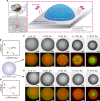Non-associative phase separation in an evaporating droplet as a model for prebiotic compartmentalization
- PMID: 34045455
- PMCID: PMC8160217
- DOI: 10.1038/s41467-021-23410-7
Non-associative phase separation in an evaporating droplet as a model for prebiotic compartmentalization
Abstract
The synthetic pathways of life's building blocks are envisaged to be through a series of complex prebiotic reactions and processes. However, the strategy to compartmentalize and concentrate biopolymers under prebiotic conditions remains elusive. Liquid-liquid phase separation is a mechanism by which membraneless organelles form inside cells, and has been hypothesized as a potential mechanism for prebiotic compartmentalization. Associative phase separation of oppositely charged species has been shown to partition RNA, but the strongly negative charge exhibited by RNA suggests that RNA-polycation interactions could inhibit RNA folding and its functioning inside the coacervates. Here, we present a prebiotically plausible pathway for non-associative phase separation within an evaporating all-aqueous sessile droplet. We quantitatively investigate the kinetic pathway of phase separation triggered by the non-uniform evaporation rate, together with the Marangoni flow-driven hydrodynamics inside the sessile droplet. With the ability to undergo liquid-liquid phase separation, the drying droplets provide a robust mechanism for formation of prebiotic membraneless compartments, as demonstrated by localization and storage of nucleic acids, in vitro transcription, as well as a three-fold enhancement of ribozyme activity. The compartmentalization mechanism illustrated in this model system is feasible on wet organophilic silica-rich surfaces during early molecular evolution.
Conflict of interest statement
The authors declare no competing interests.
Figures





Similar articles
-
Polyanion-Assisted Ribozyme Catalysis Inside Complex Coacervates.ACS Chem Biol. 2019 Jun 21;14(6):1243-1248. doi: 10.1021/acschembio.9b00205. Epub 2019 Jun 7. ACS Chem Biol. 2019. PMID: 31181897 Free PMC article.
-
Prebiotically-relevant low polyion multivalency can improve functionality of membraneless compartments.Nat Commun. 2020 Nov 23;11(1):5949. doi: 10.1038/s41467-020-19775-w. Nat Commun. 2020. PMID: 33230101 Free PMC article.
-
Practical considerations for generation of multi-compartment complex coacervates.Methods Enzymol. 2021;646:115-142. doi: 10.1016/bs.mie.2020.09.001. Epub 2020 Oct 14. Methods Enzymol. 2021. PMID: 33453923
-
Life's Biological Chemistry: A Destiny or Destination Starting from Prebiotic Chemistry?Chemistry. 2018 Nov 13;24(63):16708-16715. doi: 10.1002/chem.201801847. Epub 2018 Aug 13. Chemistry. 2018. PMID: 29870593 Review.
-
Closing the circle: replicating RNA with RNA.Cold Spring Harb Perspect Biol. 2010 Oct;2(10):a002204. doi: 10.1101/cshperspect.a002204. Epub 2010 Jun 16. Cold Spring Harb Perspect Biol. 2010. PMID: 20554706 Free PMC article. Review.
Cited by
-
Evaporation Patterns of Dextran-Poly(Ethylene Glycol) Droplets with Changes in Wettability and Compatibility.Life (Basel). 2022 Mar 4;12(3):373. doi: 10.3390/life12030373. Life (Basel). 2022. PMID: 35330124 Free PMC article.
-
In situ formation of biomolecular condensates as intracellular drug reservoirs for augmenting chemotherapy.Nat Biomed Eng. 2024 Nov;8(11):1469-1482. doi: 10.1038/s41551-024-01254-y. Epub 2024 Sep 13. Nat Biomed Eng. 2024. PMID: 39271933
-
Liquid sculpture and curing of bio-inspired polyelectrolyte aqueous two-phase systems.Nat Commun. 2023 Apr 28;14(1):2456. doi: 10.1038/s41467-023-38236-8. Nat Commun. 2023. PMID: 37117170 Free PMC article.
-
Electrolyte-Gated Organic Field-Effect Transistors for Quantitative Monitoring of the Molecular Dynamics of Crystallization at the Solid-Liquid Interface.Nano Lett. 2022 Apr 13;22(7):2643-2649. doi: 10.1021/acs.nanolett.1c04424. Epub 2022 Mar 24. Nano Lett. 2022. PMID: 35324207 Free PMC article.
-
Controlled evaporation-induced phase separation of droplets containing nanogels and salt molecules.RSC Adv. 2022 Sep 30;12(43):27977-27986. doi: 10.1039/d2ra04585k. eCollection 2022 Sep 28. RSC Adv. 2022. PMID: 36320278 Free PMC article.
References
-
- Takáts, Z. & Cooks, R. G. Thermal formation of serine octamer ions. Chem. Commun.4, 444–445 (2004). - PubMed
Publication types
MeSH terms
Substances
LinkOut - more resources
Full Text Sources
Other Literature Sources

